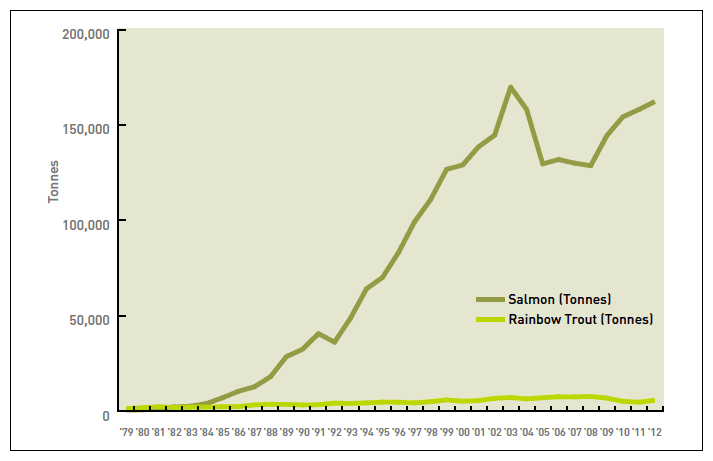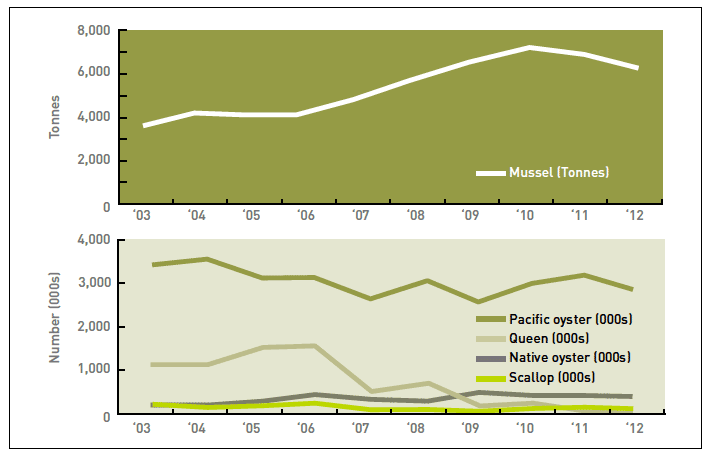MGSA Science & Research Working Group - Aquaculture Science & Research Strategy
MGSA S&RWG was tasked to produce a comprehensive research strategy prioritised on respective contribution to informing the sustainable growth of the Scottish aquaculture industry and potential impacts of the 2020 sustainable production targets as detailed
07 Capacity
Scotland produced over 162,000 tonnes of farmed Atlantic salmon in 2012 worth an estimated £600 million to the Scottish economy. Scottish shellfish farms produced approximately 6500 tonnes of mussels, oysters and scallops in 2012 (see Figures 6 and 7 below). The majority of this production comes from the inshore regions of the west coast, western and Northern Isles where farms are located in most of the suitable sheltered sea lochs and embayments. Achieving Scottish 2020 production targets will require a substantial increase in the size and/or number of fish and shellfish farms already present in these regions of Scotland and it is currently unclear what capacity limits for the inshore areas should be and where the areas of greatest expansion potential are. It is generally accepted that while there may be some additional capacity in the inshore, greatest expansion potential is in the more exposed offshore waters where there is better potential for waste assimilation, greater space availability and reduced conflicts with other sectors. However the increased production costs associated with more robust equipment, increased travelling time and more challenging Scotland produced over 162,000 tonnes of farmed Atlantic salmon in 2012 worth an estimated £600 million to the Scottish economy. Scottish shellfish farms produced approximately 6500 tonnes of mussels, oysters and scallops in 2012 (see Figures 6 and 7 below). The majority of this production comes from the inshore regions of the west coast, western and Northern Isles where farms are located in most of the suitable sheltered sea lochs and embayments. Achieving Scottish 2020 production targets will require a substantial increase in the size and/or number of fish and shellfish farms already present in these regions of Scotland and it is currently unclear what capacity limits for the inshore areas should be and where the areas of greatest expansion potential are. It is generally accepted that while there may be some additional capacity in the inshore, greatest expansion potential is in the more exposed offshore waters where there is better potential for waste assimilation, greater space availability and reduced conflicts with other sectors. However the increased production costs associated with more robust equipment, increased travelling time and more challenging environmental conditions for both stock and staff have so far prevented a change towards offshore production.
Capacity potential is limited by a number of factors. Environmental, economic and social. Economic factors relevant to capacity (market factors etc.) are dealt with in another section of this document ( 08 Markets, Economics & Social Science). Environmental limits on capacity stem from the receiving environment's ability to provide oxygen and assimilate wastes (nutrients and organic matter from fish feed, medicines and chemicals for finfish) and provide planktonic food from primary and secondary production (shellfish). Significant environmental impacts to water and sediment quality as well as marine life can result from unsustainable production levels causing breaches of environmental quality standards and the total standing biomass of aquaculture stock able to be supported without causing such adverse effects is generally referred to as the carrying capacity (assimilative or biological). Social factors influencing capacity include local community acceptance of aquaculture and the influence of local democracy on the planning regime. Local public objection to aquaculture developments plays a significant part in the restriction of aquaculture capacity and needs better understanding. Landscape and visual impacts play an important role here and the concept of landscape capacity (to impact from visible infrastructure) is well known but poorly quantified for much of Scotland's coastline. Nationally adopted science-based regulatory approaches also play a part in restricting capacity. Changes in our understanding of acceptable thresholds of environmental impact or improvements in the accuracy of regulatory tools and models could also result in changes to carrying capacity for aquaculture in specific areas.
Expanding both sectors within sustainable limits to achieve the 2020 targets will require new development consent and new discharge consent capacity (for finfish). Aquaculture planning is undertaken by Local Authorities and in the future will be conducted in accordance also with policies identified in the National Marine Plan and spatial direction that may arise in Regional Marine Plans created by Marine Planning Partnerships. Such bodies have yet to be established but will need to develop spatial guidance to identify optimum use of space for aquaculture where environmental constraints are lowest and an equitable sharing of space can be achieved with other marine uses.
There are unknowns surrounding all these areas of capacity limitation, many of which could be better addressed with improved science and research. Key gaps in understanding are identified below.
Figure 6 | Scottish farmed marine finfish production 1979-2012.

Figure 7 | Scottish farmed shellfish production 2003-2012.

Contact
There is a problem
Thanks for your feedback